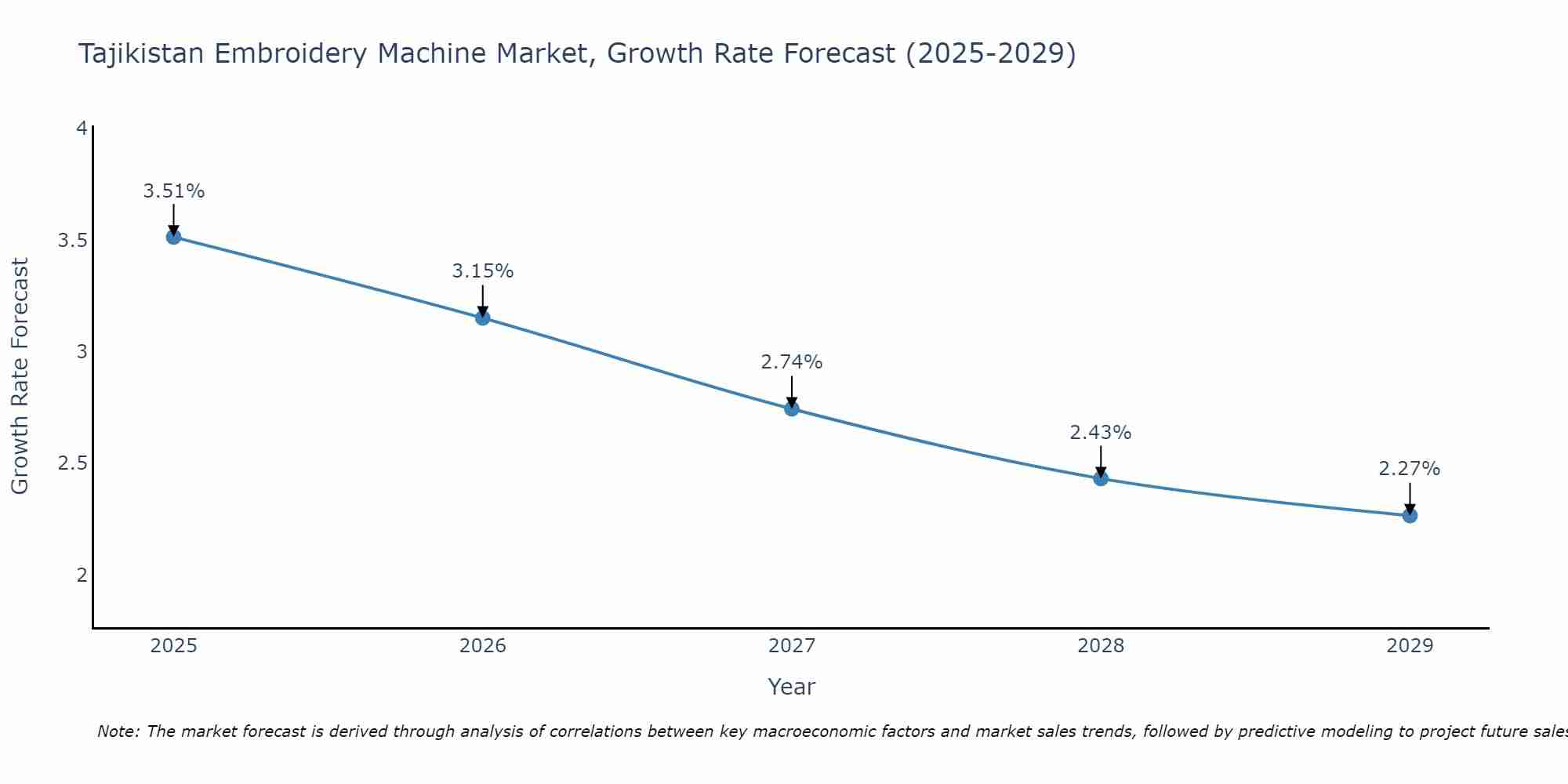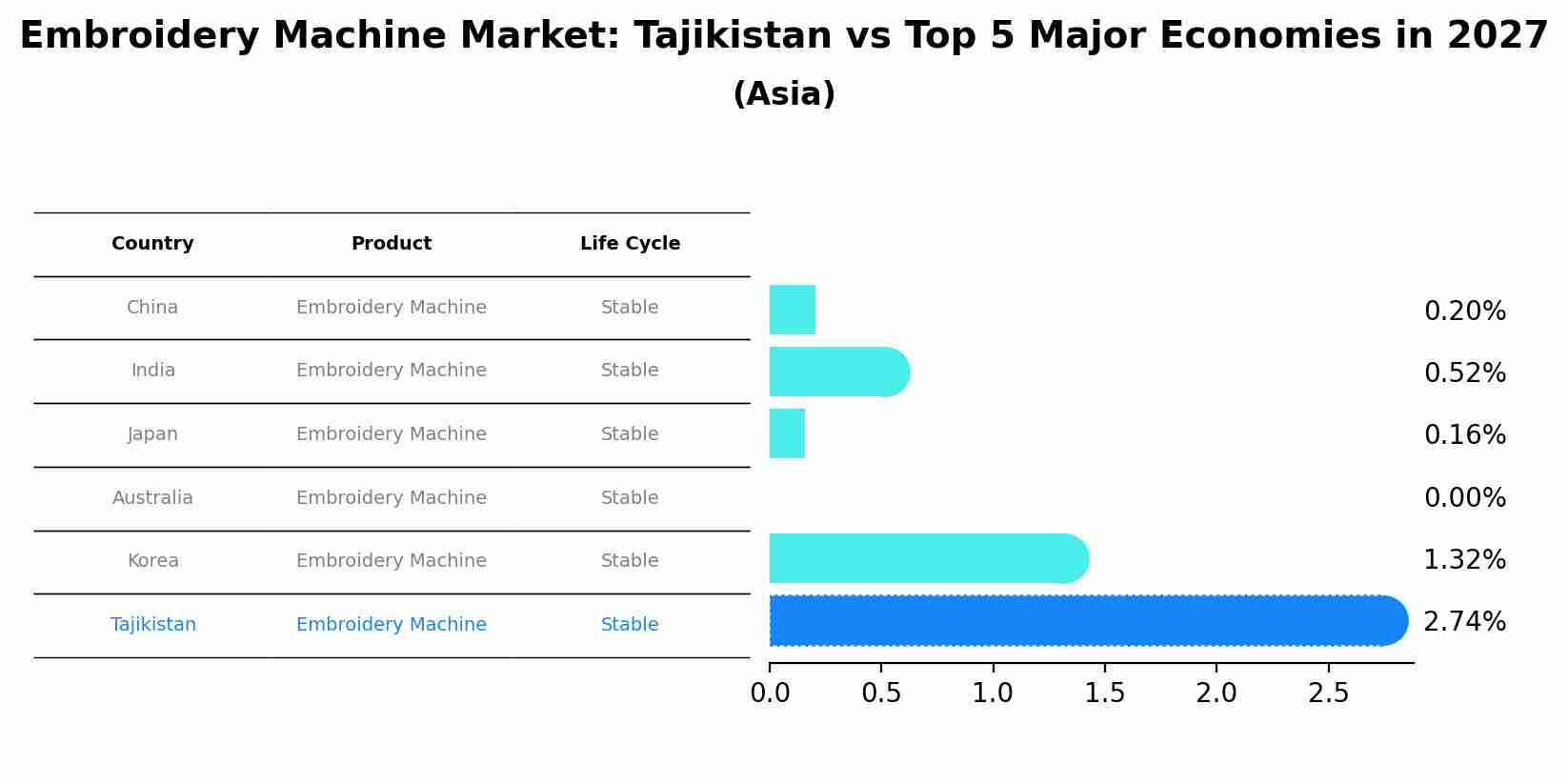Tajikistan Embroidery Machine Market (2025-2031) | Forecast, Companies, Analysis, Trends, Growth, Value, Share, Size, Industry, Revenue & Outlook
| Product Code: ETC063198 | Publication Date: Aug 2021 | Updated Date: Jun 2025 | Product Type: Report | |
| Publisher: 6Wresearch | Author: Shubham Deep | No. of Pages: 70 | No. of Figures: 35 | No. of Tables: 5 |
Tajikistan Embroidery Machine Market Size Growth Rate
The Tajikistan Embroidery Machine Market may undergo a gradual slowdown in growth rates between 2025 and 2029. Starting high at 3.51% in 2025, the market steadily declines to 2.27% by 2029.

Embroidery Machine Market: Tajikistan vs Top 5 Major Economies in 2027 (Asia)
By 2027, the Embroidery Machine market in Tajikistan is anticipated to reach a growth rate of 2.74%, as part of an increasingly competitive Asia region, where China remains at the forefront, supported by India, Japan, Australia and South Korea, driving innovations and market adoption across sectors.

Tajikistan Embroidery Machine Market Overview
The Tajikistan embroidery machine market is experiencing steady growth due to increasing demand from textile and garment industries. The market is primarily driven by the rising trend of personalized and custom-designed clothing, as well as the growing popularity of embroidery in traditional Tajik clothing. Key players in the market are focusing on introducing technologically advanced and user-friendly embroidery machines to cater to the evolving needs of businesses and individuals. Additionally, government initiatives to promote domestic manufacturing and the textile sector are expected to further boost market growth. The market is characterized by a mix of local and international manufacturers, offering a variety of embroidery machines at different price points to cater to a wide range of customers. Overall, the Tajikistan embroidery machine market presents promising opportunities for growth and innovation.
Tajikistan Embroidery Machine Market Trends
In Tajikistan, the embroidery machine market is experiencing a growing demand for advanced and computerized machines that offer a wide range of features and capabilities. Customers are increasingly looking for machines that are easy to use, versatile in terms of design options, and efficient in production. The market is also witnessing a trend towards eco-friendly and energy-efficient machines to align with sustainability initiatives. Additionally, there is a rising interest in machines that offer connectivity options for seamless integration with digital design software. Overall, the Tajikistan embroidery machine market is evolving towards more technologically advanced and environmentally conscious solutions to meet the changing needs of customers in the textile and apparel industry.
Tajikistan Embroidery Machine Market Challenges
In the Tajikistan Embroidery Machine Market, several challenges are faced. These include limited access to modern technology and machinery due to the country`s underdeveloped industrial infrastructure. The high cost of importing embroidery machines also poses a significant challenge for local businesses, hindering their ability to invest in new equipment and compete effectively in the market. Additionally, the lack of skilled labor and training programs specialized in embroidery machine operation further exacerbates the industry`s growth potential. Moreover, unreliable electricity supply and inadequate maintenance services for embroidery machines contribute to operational inefficiencies and downtime for businesses in Tajikistan. Overall, overcoming these challenges will require government support, investment in infrastructure, and capacity-building initiatives to drive the growth of the Tajikistan Embroidery Machine Market.
Tajikistan Embroidery Machine Market Investment Opportunities
Investment opportunities in the Tajikistan Embroidery Machine Market are promising due to the growing demand for embroidered textiles and garments in the country. The market is relatively untapped, presenting opportunities for investors to establish or expand businesses in the embroidery machine manufacturing, distribution, or servicing sectors. Investing in modern and efficient embroidery machines can help meet the increasing demand for high-quality embroidered products in Tajikistan and potentially export to neighboring countries. With the government`s focus on promoting the textile and apparel industry, investing in the Tajikistan Embroidery Machine Market can be a strategic move to capitalize on the country`s developing textile sector and position oneself for long-term growth and profitability.
Tajikistan Embroidery Machine Market Government Policy
The Tajikistan government has implemented policies to support the growth of the embroidery machine market in the country. These policies include providing financial incentives and subsidies to local businesses engaged in the production and distribution of embroidery machines. Additionally, the government has focused on improving infrastructure and logistics to facilitate the import of raw materials and export of finished products. To promote innovation and technology development in the sector, the government has also established partnerships with international organizations and provided training programs for local manufacturers. Overall, these policies aim to boost the competitiveness of the Tajikistan embroidery machine market and stimulate economic growth in the country.
Tajikistan Embroidery Machine Market Future Outlook
The Tajikistan Embroidery Machine Market is expected to witness steady growth in the coming years, driven by increasing demand for customized and intricate embroidered products in the textile and fashion industries. The market is likely to benefit from advancements in technology, leading to the development of more efficient and versatile embroidery machines. Additionally, the growing trend of digitalization and automation in the textile sector is anticipated to further propel the market growth. However, factors such as fluctuations in raw material prices and economic uncertainties may pose challenges to market expansion. Overall, the Tajikistan Embroidery Machine Market is forecasted to exhibit resilience and opportunities for growth, especially with the increasing focus on high-quality and unique embroidery designs in various applications.
Key Highlights of the Report:
- Tajikistan Embroidery Machine Market Outlook
- Market Size of Tajikistan Embroidery Machine Market, 2021
- Forecast of Tajikistan Embroidery Machine Market, 2031
- Historical Data and Forecast of Tajikistan Embroidery Machine Revenues & Volume for the Period 2021 - 2031
- Tajikistan Embroidery Machine Market Trend Evolution
- Tajikistan Embroidery Machine Market Drivers and Challenges
- Tajikistan Embroidery Machine Price Trends
- Tajikistan Embroidery Machine Porter's Five Forces
- Tajikistan Embroidery Machine Industry Life Cycle
- Historical Data and Forecast of Tajikistan Embroidery Machine Market Revenues & Volume By Product Type for the Period 2021 - 2031
- Historical Data and Forecast of Tajikistan Embroidery Machine Market Revenues & Volume By Single Head for the Period 2021 - 2031
- Historical Data and Forecast of Tajikistan Embroidery Machine Market Revenues & Volume By Multi Head for the Period 2021 - 2031
- Historical Data and Forecast of Tajikistan Embroidery Machine Market Revenues & Volume By Applications for the Period 2021 - 2031
- Historical Data and Forecast of Tajikistan Embroidery Machine Market Revenues & Volume By Household for the Period 2021 - 2031
- Historical Data and Forecast of Tajikistan Embroidery Machine Market Revenues & Volume By Commercial for the Period 2021 - 2031
- Historical Data and Forecast of Tajikistan Embroidery Machine Market Revenues & Volume By Industrial for the Period 2021 - 2031
- Tajikistan Embroidery Machine Import Export Trade Statistics
- Market Opportunity Assessment By Product Type
- Market Opportunity Assessment By Applications
- Tajikistan Embroidery Machine Top Companies Market Share
- Tajikistan Embroidery Machine Competitive Benchmarking By Technical and Operational Parameters
- Tajikistan Embroidery Machine Company Profiles
- Tajikistan Embroidery Machine Key Strategic Recommendations
Frequently Asked Questions About the Market Study (FAQs):
1 Executive Summary |
2 Introduction |
2.1 Key Highlights of the Report |
2.2 Report Description |
2.3 Market Scope & Segmentation |
2.4 Research Methodology |
2.5 Assumptions |
3 Tajikistan Embroidery Machine Market Overview |
3.1 Tajikistan Country Macro Economic Indicators |
3.2 Tajikistan Embroidery Machine Market Revenues & Volume, 2021 & 2031F |
3.3 Tajikistan Embroidery Machine Market - Industry Life Cycle |
3.4 Tajikistan Embroidery Machine Market - Porter's Five Forces |
3.5 Tajikistan Embroidery Machine Market Revenues & Volume Share, By Product Type, 2021 & 2031F |
3.6 Tajikistan Embroidery Machine Market Revenues & Volume Share, By Applications, 2021 & 2031F |
4 Tajikistan Embroidery Machine Market Dynamics |
4.1 Impact Analysis |
4.2 Market Drivers |
4.3 Market Restraints |
5 Tajikistan Embroidery Machine Market Trends |
6 Tajikistan Embroidery Machine Market, By Types |
6.1 Tajikistan Embroidery Machine Market, By Product Type |
6.1.1 Overview and Analysis |
6.1.2 Tajikistan Embroidery Machine Market Revenues & Volume, By Product Type, 2018 - 2027F |
6.1.3 Tajikistan Embroidery Machine Market Revenues & Volume, By Single Head, 2018 - 2027F |
6.1.4 Tajikistan Embroidery Machine Market Revenues & Volume, By Multi Head, 2018 - 2027F |
6.2 Tajikistan Embroidery Machine Market, By Applications |
6.2.1 Overview and Analysis |
6.2.2 Tajikistan Embroidery Machine Market Revenues & Volume, By Household, 2018 - 2027F |
6.2.3 Tajikistan Embroidery Machine Market Revenues & Volume, By Commercial, 2018 - 2027F |
6.2.4 Tajikistan Embroidery Machine Market Revenues & Volume, By Industrial, 2018 - 2027F |
7 Tajikistan Embroidery Machine Market Import-Export Trade Statistics |
7.1 Tajikistan Embroidery Machine Market Export to Major Countries |
7.2 Tajikistan Embroidery Machine Market Imports from Major Countries |
8 Tajikistan Embroidery Machine Market Key Performance Indicators |
9 Tajikistan Embroidery Machine Market - Opportunity Assessment |
9.1 Tajikistan Embroidery Machine Market Opportunity Assessment, By Product Type, 2021 & 2031F |
9.2 Tajikistan Embroidery Machine Market Opportunity Assessment, By Applications, 2021 & 2031F |
10 Tajikistan Embroidery Machine Market - Competitive Landscape |
10.1 Tajikistan Embroidery Machine Market Revenue Share, By Companies, 2021 |
10.2 Tajikistan Embroidery Machine Market Competitive Benchmarking, By Operating and Technical Parameters |
11 Company Profiles |
12 Recommendations |
13 Disclaimer |
- Single User License$ 1,995
- Department License$ 2,400
- Site License$ 3,120
- Global License$ 3,795
Search
Thought Leadership and Analyst Meet
Our Clients
Related Reports
- Afghanistan Apparel Market (2026-2032) | Growth, Outlook, Industry, Segmentation, Forecast, Size, Companies, Trends, Value, Share, Analysis & Revenue
- Canada Oil and Gas Market (2026-2032) | Share, Segmentation, Value, Industry, Trends, Forecast, Analysis, Size & Revenue, Growth, Competitive Landscape, Outlook, Companies
- Germany Breakfast Food Market (2026-2032) | Industry, Share, Growth, Size, Companies, Value, Analysis, Revenue, Trends, Forecast & Outlook
- Australia Briquette Market (2025-2031) | Growth, Size, Revenue, Forecast, Analysis, Trends, Value, Share, Industry & Companies
- Vietnam System Integrator Market (2025-2031) | Size, Companies, Analysis, Industry, Value, Forecast, Growth, Trends, Revenue & Share
- ASEAN and Thailand Brain Health Supplements Market (2025-2031) | Strategy, Consumer Insights, Analysis, Investment Trends, Opportunities, Growth, Size, Share, Industry, Revenue, Segments, Value, Segmentation, Supply, Forecast, Restraints, Outlook, Competition, Drivers, Trends, Demand, Pricing Analysis, Competitive, Strategic Insights, Companies, Challenges
- ASEAN Bearings Market (2025-2031) | Strategy, Consumer Insights, Analysis, Investment Trends, Opportunities, Growth, Size, Share, Industry, Revenue, Segments, Value, Segmentation, Supply, Forecast, Restraints, Outlook, Competition, Drivers, Trends, Demand, Pricing Analysis, Competitive, Strategic Insights, Companies, Challenges
- Europe Flooring Market (2025-2031) | Outlook, Share, Industry, Trends, Forecast, Companies, Revenue, Size, Analysis, Growth & Value
- Saudi Arabia Manlift Market (2025-2031) | Outlook, Size, Growth, Trends, Companies, Industry, Revenue, Value, Share, Forecast & Analysis
- Uganda Excavator, Crane, and Wheel Loaders Market (2025-2031) | Strategy, Consumer Insights, Analysis, Investment Trends, Opportunities, Growth, Size, Share, Industry, Revenue, Segments, Value, Segmentation, Supply, Forecast, Restraints, Outlook, Competition, Drivers, Trends, Demand, Pricing Analysis, Competitive, Strategic Insights, Companies, Challenges
Industry Events and Analyst Meet
Whitepaper
- Middle East & Africa Commercial Security Market Click here to view more.
- Middle East & Africa Fire Safety Systems & Equipment Market Click here to view more.
- GCC Drone Market Click here to view more.
- Middle East Lighting Fixture Market Click here to view more.
- GCC Physical & Perimeter Security Market Click here to view more.
6WResearch In News
- Doha a strategic location for EV manufacturing hub: IPA Qatar
- Demand for luxury TVs surging in the GCC, says Samsung
- Empowering Growth: The Thriving Journey of Bangladesh’s Cable Industry
- Demand for luxury TVs surging in the GCC, says Samsung
- Video call with a traditional healer? Once unthinkable, it’s now common in South Africa
- Intelligent Buildings To Smooth GCC’s Path To Net Zero


















